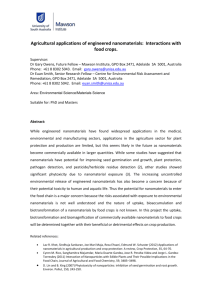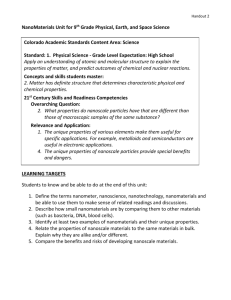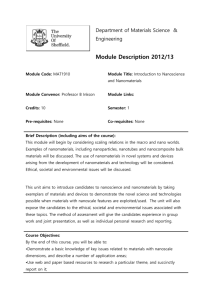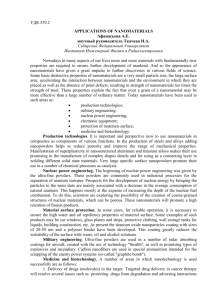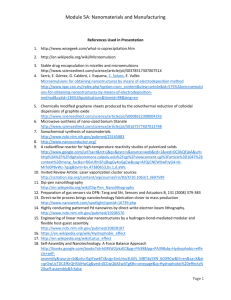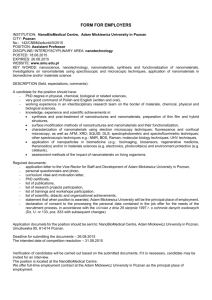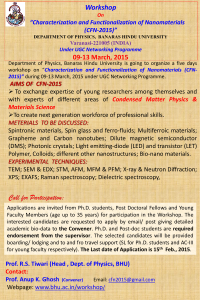Safety hazards of engineered nanomaterials
advertisement
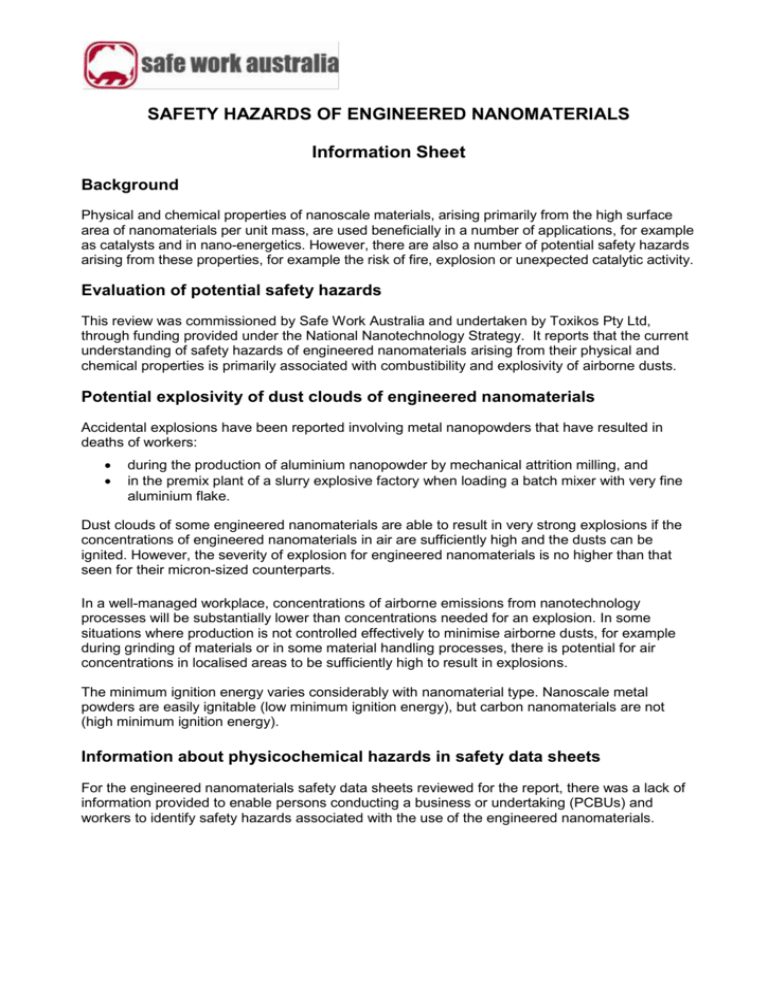
SAFETY HAZARDS OF ENGINEERED NANOMATERIALS Information Sheet Background Physical and chemical properties of nanoscale materials, arising primarily from the high surface area of nanomaterials per unit mass, are used beneficially in a number of applications, for example as catalysts and in nano-energetics. However, there are also a number of potential safety hazards arising from these properties, for example the risk of fire, explosion or unexpected catalytic activity. Evaluation of potential safety hazards This review was commissioned by Safe Work Australia and undertaken by Toxikos Pty Ltd, through funding provided under the National Nanotechnology Strategy. It reports that the current understanding of safety hazards of engineered nanomaterials arising from their physical and chemical properties is primarily associated with combustibility and explosivity of airborne dusts. Potential explosivity of dust clouds of engineered nanomaterials Accidental explosions have been reported involving metal nanopowders that have resulted in deaths of workers: during the production of aluminium nanopowder by mechanical attrition milling, and in the premix plant of a slurry explosive factory when loading a batch mixer with very fine aluminium flake. Dust clouds of some engineered nanomaterials are able to result in very strong explosions if the concentrations of engineered nanomaterials in air are sufficiently high and the dusts can be ignited. However, the severity of explosion for engineered nanomaterials is no higher than that seen for their micron-sized counterparts. In a well-managed workplace, concentrations of airborne emissions from nanotechnology processes will be substantially lower than concentrations needed for an explosion. In some situations where production is not controlled effectively to minimise airborne dusts, for example during grinding of materials or in some material handling processes, there is potential for air concentrations in localised areas to be sufficiently high to result in explosions. The minimum ignition energy varies considerably with nanomaterial type. Nanoscale metal powders are easily ignitable (low minimum ignition energy), but carbon nanomaterials are not (high minimum ignition energy). Information about physicochemical hazards in safety data sheets For the engineered nanomaterials safety data sheets reviewed for the report, there was a lack of information provided to enable persons conducting a business or undertaking (PCBUs) and workers to identify safety hazards associated with the use of the engineered nanomaterials. Regulations Australia’s work health and safety (WHS) legislation aims to protect the health and safety of workers researching, developing, manufacturing or using engineered nanomaterials. Duties under the legislation apply to working with engineered nanomaterials as they do to technologies, substances, chemicals and materials generally. These general duties require risks to be eliminated or minimised and for risks to be communicated. There are also specific WHS Regulations for workplace hazardous chemicals, which cover engineered nanomaterials in the same way as other chemicals if they are classified as hazardous. The findings of this review of the safety hazards of engineered nanomaterials have implications for duty holders under the WHS Regulations. In the Globally Harmonised System for the Classification and Labelling of Chemicals (GHS), there is currently no specific hazard category for the explosivity of dust clouds. In the GHS, a flammable solid is defined as a solid that is readily combustible or may contribute to fire through friction. Readily combustible solids are powdered, granular or pasty substances which are dangerous if they can be easily ignited by brief contact with an ignition source, such as a burning match, and if the flame spreads readily. Some nanomaterials may potentially be readily combustible solids and hence classifiable as flammable solids under the WHS Regulations. Manufacturers and importers Even if a nanomaterial is not classified as hazardous according to the GHS, the model Code of Practice for the Preparation of Safety Data Sheets recommends that an SDS be provided for engineered nanomaterials. If there is potential for a dust explosion hazard to exist when handling the engineered nanomaterial, this should be reported in the SDS. Persons conducting a business or undertaking (PCBUs), workers and process designers SDS may not provide sufficient information for identifying and assessing the physical and chemical hazards of engineered nanomaterial. The report recommends that where key properties are not known, a precautionary approach should be adopted and workplace procedures implemented to reduce or remove the possibility of dust cloud formation. Risk management approach The general risk management process is illustrated in Figure 1. Details are in the model Code of Practice: How to manage work health and safety risks and for chemicals generally in the Code of Practice: Managing risks of hazardous chemicals in the workplace. It can be applied to working safely with engineered nanomaterials. The approach to choosing controls for working with engineered nanomaterials is the same as for working with chemicals generally, for example following the hierarchy of controls. Figure 1: The risk management process Preventing accidents when working with engineered nanomaterials The report notes that there are standard measures currently used for dusty materials and dusty chemicals that can be put in place to reduce the likelihood of explosion from engineered nanomaterials. Process designers, PCBUs and workers involved in handling engineered nanomaterials should be made aware of appropriate risk controls to prevent accidents. The report notes that workplace procedures to reduce the possibility of a dust explosion could include: the use of wet processes allowing staff to work with nanomaterials in an agglomerated state or dispersed state working in well ventilated workspaces that provide efficient exhaust ventilation equipped with particle filtration implementing good housekeeping to minimise the build-up of dust layers that may be disturbed to form dust clouds using a confined process. This may include incorporation of a protection barrier to reduce the severity of an incident or a prevention barrier to reduce probability of an incident, and using an inert process i.e. a process that does not build an explosible dust/air mixture or a process that does not have ignition sources. Workplace procedures should be implemented to reduce or remove the possibility of dust cloud formation. The prevention of dust accumulation in the workplace minimises the likelihood of dust cloud formation as a result of a disturbance. Measurements to assess airborne concentrations of engineered nanomaterials can be undertaken using the approaches described in the research report recently published by Safe Work Australia entitled Measurements of Particle Emissions from Nanotechnology Processes, with Assessment of Measuring Techniques and Workplace Controls. More information Information on nanotechnology work health and safety is available on the Safe Work Australia website including: Evaluation of potential safety (physicochemical) hazards associated with the use of engineered nanomaterials Measurements of Particle Emissions from Nanotechnology Processes, with Assessment of Measuring Techniques and Workplace Controls www.safeworkaustralia.gov.au Contact Us General Enquiries Email Postal Address Media Enquiries 02 6121 5317 info@safeworkaustralia.gov.au GPO Box 641 Canberra ACT 2601 0434 644 294
